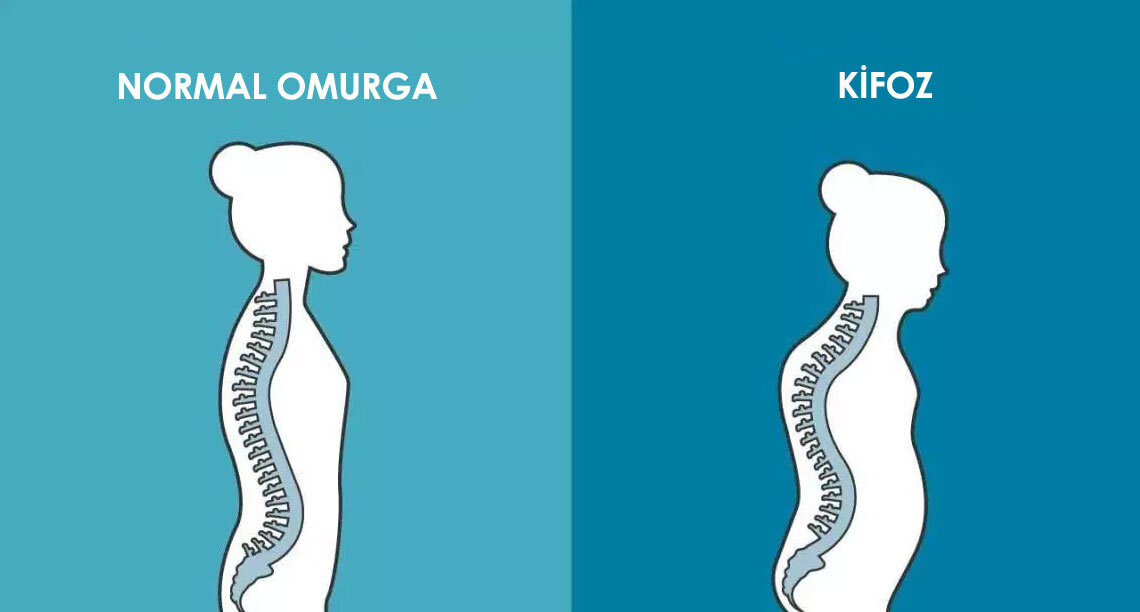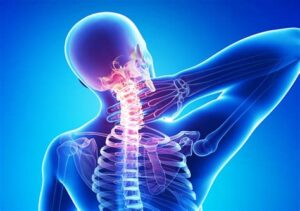
12 Mar Adult Kyphosis Treatment
Omurganın anormal şekilde öne eğilmesidir. Sırt bölgesinde kamburluk oluşur. Yetişkin kifozu, genellikle yaşlanmaya bağlı gelişir. Kemik erimesi önemli bir nedendir. Omurlar zayıflar ve çöker. Bu durum duruşu bozar. Sırt ve bel ağrısı yapabilir. Nefes almayı zorlaştırabilir. Fizik tedaviyle kontrol altına alınabilir. Ciddi vakalarda cerrahi gerekebilir. Erken teşhis tedavi sürecini kolaylaştırır.
Yetişkin Kifozu Belirtileri Nelerdir?
 Omurganın üst kısmında normalden fazla öne doğru eğrilme olur. Bu durum sırtta belirgin bir kambur oluşmasına neden olur. Kişi arkadan bakıldığında sırtının üst kısmında yuvarlaklaşma fark eder. Yetişkin kifozu omurganın doğal yapısını bozduğu için sırt ve bel bölgesinde ağrı sık görülür. Bu ağrı genellikle hareketsiz kalınca veya uzun süre ayakta durunca artar. Omurgadaki eğrilik arttıkça kişi boyunda azalma yaşar. Bu boy kısalması zamanla belirginleşir ve kıyafetlerin uyumu değişir. Omurganın normal hareketi zorlaşır. Eğilme ve gerilme hareketlerinde zorluk yaşanır.
Omurganın üst kısmında normalden fazla öne doğru eğrilme olur. Bu durum sırtta belirgin bir kambur oluşmasına neden olur. Kişi arkadan bakıldığında sırtının üst kısmında yuvarlaklaşma fark eder. Yetişkin kifozu omurganın doğal yapısını bozduğu için sırt ve bel bölgesinde ağrı sık görülür. Bu ağrı genellikle hareketsiz kalınca veya uzun süre ayakta durunca artar. Omurgadaki eğrilik arttıkça kişi boyunda azalma yaşar. Bu boy kısalması zamanla belirginleşir ve kıyafetlerin uyumu değişir. Omurganın normal hareketi zorlaşır. Eğilme ve gerilme hareketlerinde zorluk yaşanır.
Kifoz ilerledikçe günlük aktivitelerde kısıtlanma olur. İleri derecede kifozda göğüs kafesi daralabilir. Bu da akciğer kapasitesini azaltarak nefes almayı zorlaştırır. Nefes darlığı ve halsizlik görülebilir. Omurgayı destekleyen kaslar sürekli gerildiği için yorgunluk ve güç kaybı yaşanabilir. Bu durum kişinin fiziksel dayanıklılığını düşürür. Nadiren omurilik veya sinir kökleri baskı altında kalabilir. Bu durumda kollarda ve bacaklarda uyuşma, karıncalanma ya da güç kaybı olabilir. Yetişkin kifozu belirtileri genellikle yavaş ilerler ve başlangıçta hafif olur. Ancak zamanla yaşam kalitesini etkileyebilir. Bu yüzden belirtiler fark edildiğinde uzman doktora başvurmak önemlidir.
Yetişkin Kifozu Neden Olur?
Osteoporoz, kemiklerin zayıflaması ve kırılgan hale gelmesi durumudur. Bu durumda omurlar normalden daha kolay kırılır veya çöker. Omurların çökmesi ise sırtın üst kısmında kamburlaşmaya yol açar. Bu nedenle yetişkin kifozunun en yaygın nedenlerinden biridir. Kemiklerin zayıflaması omurganın doğal eğrisini bozarak kifoz oluşmasına sebep olur. Omurga bölgesinde yaşanan kırıklar veya travmalar omurların şeklini bozabilir. Özellikle düşme veya trafik kazası gibi ciddi yaralanmalar sonrası omurlar zarar görebilir. Bu durum omurganın eğrilmesine ve kifozun ortaya çıkmasına yol açar.
Yaralanma sonrası iyileşme sırasında omurga normal şeklini koruyamayabilir. Omurlar arasında yer alan diskler zamanla yıpranabilir veya hasar görebilir. Disklerin incelmesi veya şekil değiştirmesi omurganın doğal hizasını etkiler. Bu durum omurgada eğriliklerin oluşmasına neden olabilir. Disk hastalıkları yetişkin kifozunun sebepleri arasında önemli bir yer tutar. Sırt kaslarının zayıflaması veya düzgün çalışmaması kifoz gelişimini tetikleyebilir. Kaslar omurgayı destekleyip dik tutar. Kasların zayıflaması veya uzun süre kötü duruş alışkanlıkları, omurganın öne doğru eğilmesine ve kamburlaşmaya neden olur.
Özellikle hareketsiz yaşam tarzı bu durumu artırır. Bazı kişilerde kifoz çocuklukta veya doğuştan ortaya çıkar. Ancak bu durum yetişkinlikte ilerleyip daha belirgin hale gelebilir. Bu tip kifoz genellikle omurganın yapısal bozukluklarından kaynaklanır. Doğuştan gelen eğrilikler zamanla artabilir ve adult kyphosis vakalarına dönüşebilir. Omurgada meydana gelen enfeksiyonlar veya tümörler omurların yapısını bozabilir. Bu durum omurganın eğrilmesine yol açarak kifoz gelişimine neden olur.
Enfeksiyonlar kemik dokusuna zarar verip omurun çökmesine sebep olabilir. Tümörler ise omurgada basınç yaparak eğrilik oluşturabilir. Ankilozan spondilit gibi bazı romatizmal hastalıklar omurgada sertleşme ve eğrilik yaratabilir. Bu hastalıklarda omurgadaki eklemler iltihaplanır ve hareket kabiliyeti azalır. Sonuçta omurga doğal kıvrımını kaybeder ve kifoz gelişir. Bu maddeler adult kyphosis vakalarının en önemli nedenleridir. Kifozun sebebi çoğunlukla birden fazla faktörün bir araya gelmesiyle ortaya çıkar.
Yetişkin Kifozu Tedavi Yöntemleri Nelerdir?
 Yetişkin kifozu tedavisinde ilk ve en yaygın yöntemlerden biri fizik tedavi programlarıdır. Bu programda kişinin omurga kaslarını güçlendirmeye ve esnekliği artırmaya yönelik egzersizler yer alır. Özellikle sırt ve karın kaslarını çalıştırmak önemlidir. Düzenli yapılan egzersizler postürün düzelmesine yardımcı olur ve ağrıları azaltır. Fizik tedavi sayesinde omurga üzerindeki baskı hafifler ve hareket kabiliyeti artar. Kifozda ağrı şikayetleri sık görülebilir. Bu yüzden ağrı yönetimi önemli bir tedavi parçasıdır.
Yetişkin kifozu tedavisinde ilk ve en yaygın yöntemlerden biri fizik tedavi programlarıdır. Bu programda kişinin omurga kaslarını güçlendirmeye ve esnekliği artırmaya yönelik egzersizler yer alır. Özellikle sırt ve karın kaslarını çalıştırmak önemlidir. Düzenli yapılan egzersizler postürün düzelmesine yardımcı olur ve ağrıları azaltır. Fizik tedavi sayesinde omurga üzerindeki baskı hafifler ve hareket kabiliyeti artar. Kifozda ağrı şikayetleri sık görülebilir. Bu yüzden ağrı yönetimi önemli bir tedavi parçasıdır.
Doktorlar genellikle ağrı kesici veya anti-inflamatuar ilaçlar reçete eder. Bu ilaçlar kas spazmlarını azaltır ve günlük aktivitelerin daha rahat yapılmasını sağlar. Ağrı şiddetliyse veya iltihap varsa doktor farklı ilaçlar da önerebilir. Bazı hastalarda kifozun ilerlemesini durdurmak veya düzeltmek için korseler kullanılır. Bu ortopedik destekler, omurgayı doğru pozisyonda tutmaya yardımcı olur. Korse kullanımı özellikle hafif ve orta dereceli kifozlarda faydalıdır. Ancak yetişkinlerde kemik yapısı sert olduğu için korse tedavisinin etkisi sınırlı olabilir ve genellikle diğer yöntemlerle birlikte uygulanır.
Kifoz tedavisinde günlük yaşam alışkanlıklarının değiştirilmesi önemlidir. Oturma, kalkma, yatma gibi hareketlerde dikkatli olmak gerekir. Ağır yük kaldırmaktan kaçınılmalıdır. Ayrıca kilo kontrolü yapmak da omurgaya binen yükü azaltır. Postürün düzeltilmesi için ergonomik mobilyalar tercih edilmelidir. Uzun süre aynı pozisyonda kalmamak ve düzenli ara vermek kifozun kötüleşmesini önler. Ağrıyı azaltmak için omurga çevresine steroid veya diğer ağrı kesici enjeksiyonlar yapılabilir. Bu yöntem, özellikle omurga sinirlerinin baskı altında olduğu durumlarda uygulanır. Enjeksiyonlar inflamasyonu azaltır ve ağrının geçici olarak kontrol altına alınmasını sağlar.
Ancak uzun vadeli bir çözüm değildir ve genellikle diğer tedavi yöntemleriyle birlikte kullanılır. Yetişkin kifozu vakalarında şiddetli deformasyon, ilerleyici ağrı ve nörolojik sorunlar varsa cerrahi tedavi gerekebilir. Cerrahide amaç omurganın düzgün hizalanmasını sağlamak ve sinir baskısını ortadan kaldırmaktır. Ameliyat sonrası omurga plakaları, vidalar veya çubuklar ile desteklenir. Cerrahi riskleri ve iyileşme süreci dikkate alınarak sadece gerekli durumlarda tercih edilir. Tedavide kişiye özel planlama yapılması gerekir. Doktorlar genellikle bu yöntemlerden bir veya birkaçını birlikte kullanarak tedavi sürecini yönetir. En iyi sonuç için erken teşhis ve düzenli takip önemlidir.



Sorry, the comment form is closed at this time.